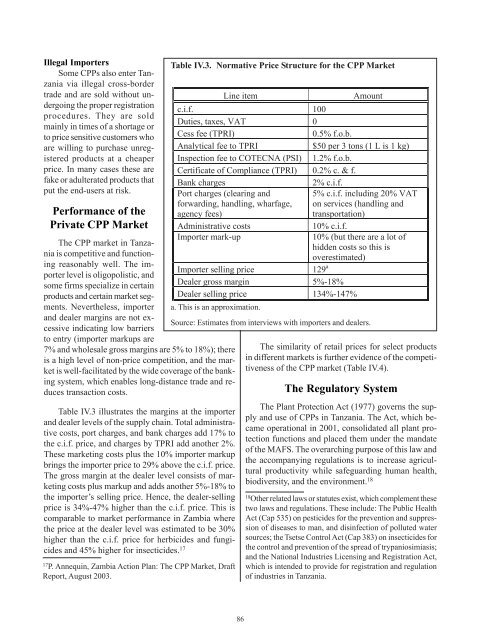An Action Plan for Developing Agricultural Input Markets in Tanzania
An Action Plan for Developing Agricultural Input Markets in Tanzania
An Action Plan for Developing Agricultural Input Markets in Tanzania
You also want an ePaper? Increase the reach of your titles
YUMPU automatically turns print PDFs into web optimized ePapers that Google loves.
Illegal Importers<br />
Some CPPs also enter <strong>Tanzania</strong><br />
via illegal cross-border<br />
trade and are sold without undergo<strong>in</strong>g<br />
the proper registration<br />
procedures. They are sold<br />
ma<strong>in</strong>ly <strong>in</strong> times of a shortage or<br />
to price sensitive customers who<br />
are will<strong>in</strong>g to purchase unregistered<br />
products at a cheaper<br />
price. In many cases these are<br />
fake or adulterated products that<br />
put the end-users at risk.<br />
Per<strong>for</strong>mance of the<br />
Private CPP Market<br />
The CPP market <strong>in</strong> <strong>Tanzania</strong><br />
is competitive and function<strong>in</strong>g<br />
reasonably well. The importer<br />
level is oligopolistic, and<br />
some firms specialize <strong>in</strong> certa<strong>in</strong><br />
products and certa<strong>in</strong> market segments.<br />
Nevertheless, importer<br />
and dealer marg<strong>in</strong>s are not excessive<br />
<strong>in</strong>dicat<strong>in</strong>g low barriers<br />
to entry (importer markups are<br />
7% and wholesale gross marg<strong>in</strong>s are 5% to 18%); there<br />
is a high level of non-price competition, and the market<br />
is well-facilitated by the wide coverage of the bank<strong>in</strong>g<br />
system, which enables long-distance trade and reduces<br />
transaction costs.<br />
a. This is an approximation.<br />
Table IV.3 illustrates the marg<strong>in</strong>s at the importer<br />
and dealer levels of the supply cha<strong>in</strong>. Total adm<strong>in</strong>istrative<br />
costs, port charges, and bank charges add 17% to<br />
the c.i.f. price, and charges by TPRI add another 2%.<br />
These market<strong>in</strong>g costs plus the 10% importer markup<br />
br<strong>in</strong>gs the importer price to 29% above the c.i.f. price.<br />
The gross marg<strong>in</strong> at the dealer level consists of market<strong>in</strong>g<br />
costs plus markup and adds another 5%-18% to<br />
the importer’s sell<strong>in</strong>g price. Hence, the dealer-sell<strong>in</strong>g<br />
price is 34%-47% higher than the c.i.f. price. This is<br />
comparable to market per<strong>for</strong>mance <strong>in</strong> Zambia where<br />
the price at the dealer level was estimated to be 30%<br />
higher than the c.i.f. price <strong>for</strong> herbicides and fungicides<br />
and 45% higher <strong>for</strong> <strong>in</strong>secticides. 17<br />
17 P. <strong>An</strong>nequ<strong>in</strong>, Zambia <strong>Action</strong> <strong>Plan</strong>: The CPP Market, Draft<br />
Report, August 2003.<br />
Table IV.3. Normative Price Structure <strong>for</strong> the CPP Market<br />
Source: Estimates from <strong>in</strong>terviews with importers and dealers.<br />
86<br />
The similarity of retail prices <strong>for</strong> select products<br />
<strong>in</strong> different markets is further evidence of the competitiveness<br />
of the CPP market (Table IV.4).<br />
The Regulatory System<br />
The <strong>Plan</strong>t Protection Act (1977) governs the supply<br />
and use of CPPs <strong>in</strong> <strong>Tanzania</strong>. The Act, which became<br />
operational <strong>in</strong> 2001, consolidated all plant protection<br />
functions and placed them under the mandate<br />
of the MAFS. The overarch<strong>in</strong>g purpose of this law and<br />
the accompany<strong>in</strong>g regulations is to <strong>in</strong>crease agricultural<br />
productivity while safeguard<strong>in</strong>g human health,<br />
biodiversity, and the environment. 18<br />
18 Other related laws or statutes exist, which complement these<br />
two laws and regulations. These <strong>in</strong>clude: The Public Health<br />
Act (Cap 535) on pesticides <strong>for</strong> the prevention and suppression<br />
of diseases to man, and dis<strong>in</strong>fection of polluted water<br />
sources; the Tsetse Control Act (Cap 383) on <strong>in</strong>secticides <strong>for</strong><br />
the control and prevention of the spread of trypaniosimiasis;<br />
and the National Industries Licens<strong>in</strong>g and Registration Act,<br />
which is <strong>in</strong>tended to provide <strong>for</strong> registration and regulation<br />
of <strong>in</strong>dustries <strong>in</strong> <strong>Tanzania</strong>.

















